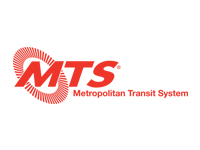Client:

Date Started:
Date Completed:
Location:
About Project
This project designed an additional track and station platform modifications to allow for the Green Line and the Orange Line to terminate at the El Cajon Transit Center. This will allow MTS to flexibly operate over a frequently delayed one-mile single track segment between Gillespie Field Station and Santee, through introduction of a two-car trolley shuttle at El Cajon Transit Center to serve the remaining stops to Santee. This new shuttle would reduce operational impacts that cascade within MTS lines, while maintaining service through a trolley transfer for passengers travelling east of El Cajon. The El Cajon Transit Center has at grade tracks at Palm Avenue and are grade separated at Main Street. The station and tracks are on an elevated retained fill structure above the parking lot and drop off areas. In addition, there is a bus station with 9 bus bays.
Project Scope, Successes
Pacific Railway Enterprises (PRE) provided transit signal final design, vital and non-vital train control and station communications final design, technical specifications, and cost estimates for the project. The signal improvements for the project included constructing two new rail cases, new signal indicators with pushbutton request, power switches, TWC loops and impedance bonds. New ElectrologIXS microprocessors were designed to control the new rail case locations. The communications improvements included relocation of the existing station communications cabinet, which was in conflict with the new elevated third track, determination of new cable paths to station platform devices, and fiber optic network changes.
When the systems estimate was higher than originally anticipated for the project, PRE supported a design modification that reversed the existing crossover near Wagner Drive. This change required rail case modifications, rather than a new rail case, reducing cost. It also eliminated an ElectrologIXS and addressed property constraints that were impacting the location of the new rail case. The existing rail case is currently utilizing relay logic and introduced complexity in modifications to the design.
Within the project limits, MTS fiber optic cable transitioned from aerial on catenary to underground to serve the station platform. The new track alignment created conflict with existing Overhead Catenary System (OCS) poles that contained aerial fiber. PRE coordinated with OCS design to determine fiber phasing. The new track alignment also required the existing eastbound station platform to be narrowed and become a center platform for the third track. There was little current documentation of the existing station systems available. PRE provided cost effective engineering to address this through multiple field verification visits to document current conditions and was able to leverage our existing understanding of MTS station platform systems. The station systems design coordinated with other disciplines, such as electrical, OCS, structures, track, and civil to determine the sequencing of modifications that facilitated complex construction phasing for the platform, with the goal of maintaining partial platform operations for passengers during construction.
Project Highlights
• Produced 100% level design drawings, specifications and estimates.
• Utilized ElectrologIXS platform for improved long-term support and increased competition.
• Made design changes to existing relay logic to support reverse of existing crossover for overall cost reduction.
• Coordinated with the design team to determine optimal fiber optic cable modifications.
• Coordinated with electrical, OCS, structures, track, and civil to determine complex construction phasing to reduce impact to platform systems, keeping them operational for passengers.

